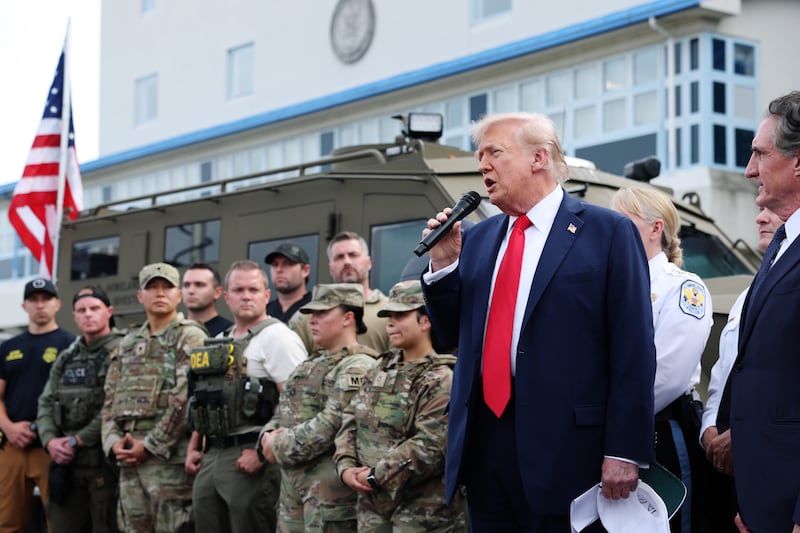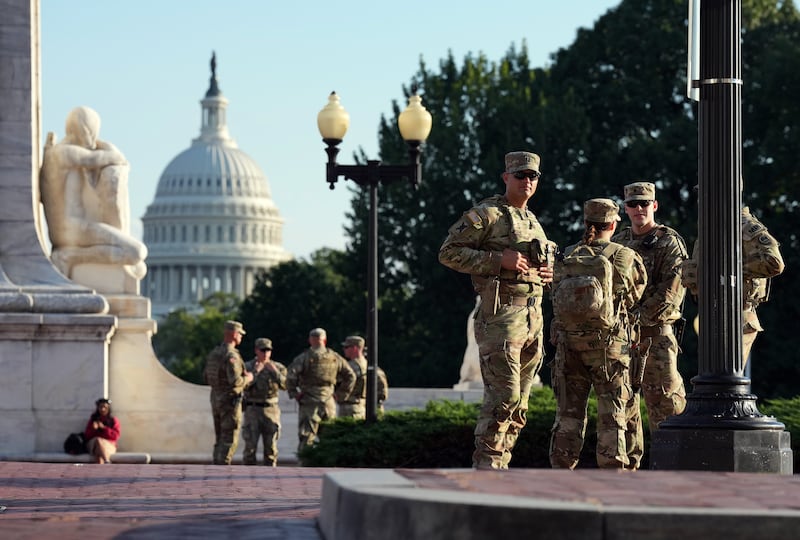The District of Columbia is on tenterhooks, wondering what else Mad King Trump might do to further erode home rule and use America’s capital city to acclimate the country to military occupation. Restrictive gun laws are no longer enforced, and FBI agents have been surged into the Capitol to bolster Immigration and Customs Enforcement (ICE) in apprehending people without legal documentation.
National Guard troops, initially unarmed, now carry visible weapons as they patrol areas around the Capitol and National Mall. These weekend warriors, men and women pulled from their jobs and families, are not trained in urban crime-fighting. They appear to be in D.C. mostly for show—and to pick up trash, it turns out.
Loaded weapons at the ready, an untested Defense secretary eager to please his boss, and a city in the throes of a hostile takeover. What could go wrong?
Kent State is the cautionary tale. National Guardsmen called in to quell an anti-war protest on the university campus in Ohio opened fire on May 4, 1970, killing four people and wounding nine others. It’s an event seared into memory by the photo of a young protester, her face anguished, kneeling by the body of a slain student.

The tragic incident triggered massive protests across the country against the Vietnam War and President Richard Nixon’s expansion of the fighting into Cambodia. Still, polling from the American Institute of Public Opinion showed only about one in ten people blamed the National Guard for the deaths and injuries; a majority of those responding sided with the Guardsmen against the student protestors.
Just four days after the Kent State violence, construction workers in New York City carrying huge American flags and chanting “All the way U.S.A.,” attacked student protesters in the city’s financial district, savagely beating them and pursuing them to nearby Pace College in what became known as the “hardhat riot.” It was the working man’s show of disgust against the long-haired hippie protestors. Political fault lines were laid bare, “and Nixon, with his instinct for the base, invited the union leaders to the White House,” recounted Jack Pitney, professor of politics at Claremont McKenna College. Upon their visit, they gifted the president with a ceremonial hard hat.
“I’d be astonished if [Trump] didn’t remember it,” Pitney continued. “He was just getting started as a realtor and builder in Manhattan,” and it was an early lesson that being “tough on crime” is good politics. Your own crimes (and convictions) notwithstanding, of course.
Here we are a half-century later, then, and Democrats are once again back on their heels, trying to figure out how to counteract Trump’s exaggerated portrayal of how dangerous D.C. and other blue cities are without being characterized as pro-crime.
“If I were a Democrat, I would stand with the National Guardsmen, people who have lives and jobs and have been mobilized unnecessarily, taken from their spouses and families, and potentially being put into a confrontation they haven’t been trained for,” Pitney said.
In a speech Wednesday, D.C. Mayor Bowser said essentially the same thing, crediting the “federal surge” for an 87 percent reduction in carjackings over a 20-day period.

Perhaps that’s why Trump is calling for the creation of “specialized units” within the National Guard to “enforce public safety and order.” He talks of sending the Guard into other blue cities like Chicago and Baltimore, but he’s gotten pushback. Illinois Governor J.B. Pritzker told Trump, “You are neither wanted here nor needed here.”
The Guardsmen deployed in D.C. are mainly in public areas—around the U.S. Capitol and the Mall, where they are seen by tourists and visitors to the city. After multiple reports claiming they have little to do, their rules of engagement have seemingly been altered to include beautification projects like spreading mulch around the cherry trees at the Tidal Basin and picking up trash wherever they see it.
Make it make sense? Well, Trump started this whole crusade against D.C. as a clean-up because he didn’t like seeing homeless people in tents under highway overpasses when he was being driven to his golf course.

The National Guard soldiers are props—a show of force meant to tee up the issue of crime for the GOP.
The real problem in D.C. is ICE agents who arrive in unmarked cars, wearing street clothes with black vests. They set up checkpoints where they are bolstered and emboldened by other feds, sometimes identified as FBI or Homeland Security. No longer a professional enforcement unit, they now act as Trump’s private militia. Onlookers documented on phones as they grabbed a delivery guy, threw him to the ground, and repeatedly kicked him before hauling him away to who knows where. When an onlooker said, “You guys are ruining this country. You know that, right?,” an ICE agent replied, “Liberals already ruined it.”
Now that the Big Beautiful Bill has bombed with voters, Trump is in desperate need of a legislative victory ahead of the midterms. So it’s little surprise that he’s suddenly all in on a newly-invented “comprehensive crime bill” to distract from rising inflation, onerous tariffs, and the Epstein files.
Trump may be cleaning up crime for a short period of time, bragging that a 12-day streak without homicides was the first in years—when the city had two seven-day periods without murders in April and May, and a 16-day period earlier in the year. Even so, it’s hard to see any longtime benefits in what he’s doing. He’s starved D.C. of resources, withholding a billion dollars of taxpayer money that would have funded social services for high-crime neighborhoods and the hiring of more police.
More ominous, he’s playing with fire if he pushes for a continued military presence after the 30-day period allowed under the law ends. Democratic mayors and governors will not allow U.S. cities to become Trump’s Game of Thrones.
The post Opinion: Trump’s DC Crackdown Risks Another Kent State Massacre appeared first on The Daily Beast.




